Loading AI tools
Combined military forces of Honduras From Wikipedia, the free encyclopedia
The Armed Forces of Honduras (Spanish: Fuerzas Armadas de Honduras), consists of the Honduran Army, Honduran Navy and Honduran Air Force.
| Armed Forces of Honduras | |
|---|---|
| Fuerzas Armadas de Honduras (Spanish) | |
 Coat of arms of the Honduran Armed Forces | |
| Founded | 1825 |
| Service branches | Honduran Army Honduran Air Force Honduran Navy |
| Website | Official website |
| Leadership | |
| Commander-in-Chief | Xiomara Castro |
| Minister of Defence | Rixi Moncada |
| Chairman of the Joint Chiefs of Staff | GEN Roosevelt Hernández Aguilar |
| Personnel | |
| Military age | 18 for voluntary 2–3-year service |
| Available for military service | 1,868,940[1] males, age 16–49, 1,825,770 (2008 est.) females, age 16–49 |
| Fit for military service | 1,397,938 males, age 16–49, 1,402,398 (2009 est.) females, age 16–49 |
| Reaching military age annually | 92,638 males, 88,993 (2009 est.) females |
| Active personnel | 52,225[2] |
| Expenditure | |
| Budget | $405,000,000[3] |
| Percent of GDP | 1.1% as of 2012[3] |
| Industry | |
| Foreign suppliers | |
| Related articles | |
| Ranks | Military ranks of Honduras |
The Armed Forces of Honduras were created through article 44, subsection 4 of the First Constitution of the Legislative Chamber in 1825, with the First Supreme Head of State being the Attorney Dionisio de Herrera, for which, they ordered the effective birth of the Honduran army in dated December 11, 1825 and for its greater mobility, it was divided into battalions with the name of each of the seven departments Comayagua the capital, Tegucigalpa, Choluteca, Olancho, Yoro, Gracias and Santa Bárbara that were in charge of strategically and tactically covering order and defense of the state, under French military doctrine. In 1831 the Military School was created with a seat at the San Francisco Barracks, and Colonel Narciso Benítez of Colombian origin was appointed director; From this school graduated: Francisco Morazán, José Antonio Márquez, Diego Vigil, Liberato Moncada, Joaquín Rivera and José Santos Guardiola who were presidents of Honduras, among others.
The first weaponry used was flintlock and gunpowder, the product of mixing sulfur, saltpeter, and coal in relative quantities: the Remington single-load rifle was one of the first bullet rifles that were introduced into the country during the government of General José María Medina. .
The second stage of the Armed Forces is between the years 1842 and 1876 when the collective uniform emerged in the mid-1840s when the troops of General José Santos Guardiola faced those of General Nicolás Ángulo, in 1845 in the " Combate del Obrajuelo ", in San Miguel, El Salvador. In 1865 the first attempt was made to organize a Naval Force with its respective regulations; however, the cost of this service made it unsustainable; However, there were several attempts to reactivate the idea and one of them was carried out by Doctor Policarpo Bonilla, who ordered the construction of the Tatumbla steamship in the Kiel shipyard, Germany on November 22, 1895, and then in 1896 respectively, General Manuel Bonilla had the 'Hornet built. While he administered Honduras, the Doctor and General Don Tiburcio Carias Andino also ordered the construction of the steamers Búfalo and El Tigre. On January 1, 1881, the first Military Code of the Honduran army was issued, a legal instrument to govern its own organization. During the twentieth century, Honduran military leaders frequently became presidents, either through elections or by coups d'état. General Tiburcio Carías Andino was elected in 1932, he later on called a constituent assembly that allowed him to be reelected, and his rule became more authoritarian until an election in 1948.
During the following decades, the military of Honduras carried out several coups d'état, starting in October 1955. General Oswaldo López Arellano carried out the next coup in October 1963 and a second in December 1972, followed by coups in 1975 by Juan Alberto Melgar Castro and in 1978 by Policarpo Paz García.
Events during the 1980s in El Salvador and Nicaragua led Honduras – with US assistance – to expand its armed forces considerably, laying particular emphasis on its air force, which came to include a squadron of US-provided F-5s.
The military unit Battalion 316 carried out political assassinations and the torture of suspected political opponents of the government during this same period. Battalion members received training and support from the United States Central Intelligence Agency, in Honduras, at U.S. military bases[4] and in Chile during the presidency of the dictator Augusto Pinochet.[5] Amnesty International estimated that at least 184 people "disappeared" from 1980 to 1992 in Honduras, most likely due to actions of the Honduran military.[6]
The resolution of the civil wars in El Salvador and Nicaragua, and across-the-board budget cuts made in all ministries, has brought reduced funding for the Honduran Armed Forces. The abolition of the draft has created staffing gaps in the now all-volunteer armed forces. The military is now far below its authorized strength, and further reductions are expected. In January 1999, the Constitution was amended to abolish the position of military Commander-in-Chief of the Armed Forces, thus codifying civilian authority over the Military.
Since 2002, soldiers have been involved in crime prevention and law enforcement, patrolling the streets of the major cities alongside the national police.
On 28 June 2009, in the context of a constitutional crisis, the Military, acting on orders of the Supreme Court of Justice, arrested the President Manuel Zelaya, after which they forcibly removed elected President Zelaya from Honduras. See the article 2009 Honduran constitutional crisis regarding claims regarding legitimacy and illegitimacy of the event, and events preceding and following the removal of Zelaya from Honduras.
The military's chief lawyer, Colonel Herberth Bayardo Inestroza Membreño, made public statements regarding the removal of Zelaya. On June 30, he showed a detention order, apparently signed June 26 by a Supreme Court judge, which ordered the armed forces to detain the president.[7] Colonel Inestroza later stated that deporting Zelaya did not comply with the court order: "In the moment that we took him out of the country, in the way that he was taken out, there is a crime. Because of the circumstances of the moment this crime occurred, there is going to be a justification and cause for acquittal that will protect us."[8] He said the decision was taken by the military leadership "in order to avoid bloodshed".[9]
Following the 2009 ouster of the president, the Honduran military together with other government security forces were allegedly responsible for thousands of allegedly arbitrary detentions[10] and for several forced disappearances and extrajudicial executions of opponents to the de facto government, including members of the Democratic Unification Party. However, evidence about these actions has yet to be provided and there has been some questioning in local media about the actual perpetrators, suggesting that they could actually be related to disputes within the leftists organizations themselves.[11][12][13][14][15][16]
This section needs expansion with: How large is the army, how is it structured, where are army bases located.. You can help by adding to it. (July 2015) |
The Honduran Army (Spanish: Ejército de Honduras, lit. 'Army of Honduras') is the land service branch of the Armed Forces of Honduras.
The FAH operates from four air bases located at:
With the exception of Soto Cano Air Base, all other air bases operate as dual civil and military aviation facilities.
Additionally, three air stations are located at:
Also a radar station operates at:
The Navy is a small force dealing with coastal and riverine security.
The Navy has 71 patrol boats, interceptors and landing craft units.
| Class | Origin | Type | Versions | In service | Fleet |
|---|---|---|---|---|---|
| ISRAEL SHIPYARDS Sa'ar 62-class offshore patrol vessel 62.0 meters / 204 feet | Ocean patrol vessel | OPV-62M | 1 | FNH-2021 General Trinidad Cabañas Delivered by Israel Shipyard and arrived in country December 2019 | |
| Damen Stan Patrol Boat 42.8 meters / 140 feet | Coastal patrol vessel | 4207 | 2 | FNH-1401 Lempira FNH-1402 General Francisco Morazán | |
| LANTANA BOATYARD Guardian Patrol Boats 32.3 meters / 107 feet | Coastal patrol craft | 3 | FNH-1071 Tegucigalpa[18] FNH-1072 Copán FNH-1073 unknown name | ||
| SWIFTSHIPS Patrol Boats 32.0 meters / 105 feet | Coastal patrol craft | 3 | FNH-1051 Guaymuras FNH-1052 Honduras FNH-1053 Hibueras | ||
| IAI Dabur Type Patrol Boat 26.0 meters / 85 feet | Coastal patrol craft | 1 | FNH-8501 Chamelecón | ||
| SWIFTSHIPS Patrol Boats 20.0 meters / 65 feet | Coastal patrol craft | 5 | FNH 6501 Nacaome FNH 6502 Goascorán FNH 6503 Patuca FNH 6504 Ulúa FNH 6505 Choluteca | ||
| BOSTON WHALER Interceptors BW370 11.4 meters / 38 feet | Interceptor boat | Guardian class | 10 | N/A | |
| DAMEN Interceptors 1102 UHS 11.0 meters / 36 feet | Interceptor boat | 1102 UHS | 6 | FNH-3601 to FNH-3606 | |
| SAFE BOATS 35MMI Multi Misión Interceptor 10.7 meters / 35 feet | Interceptor boat | 35 MMI | 2[19] | FNH-3501 FNH-3502 | |
| EDUARDOÑO Patrullero 320 10.0 meters / 32 feet | Interceptor boat | 25 | FNH-3201 to FNH-3225 | ||
| NAPCO Piraña Patrol Boats 4.0 meters / 13 feet | Riverine ops boat | Piraña class | 8 | ||
| LANTANA BOATYARD Landing Craft Unit 45.5 meters / 149 feet | Coastal transport | 1 | FNH-1491 Punta Caxinas | ||
| COTECMAR BAL-C Short Range Logistic Support Ship 49.0 meters / 161 feet | Short Range Logistic Support Ship | BAL-C | 1 | FNH-1611 Gracias a Dios[20][21][22] | |
| SWIFTSHIPS LCM-8 Landing Craft Unit 22.9 meters / 75 feet | Landing craft | 3 | FNH-7301 Warunta FNH-7302 Rio Coco FNH-7303 unknown name |
The Honduran navy has 4 naval bases:
Additionally, the Honduran navy has the following unit and schools:
According to a statement in July 2009 by a legal counsel of the Honduras military, Colonel Herberth Bayardo Inestroza, part of the elite Honduran Military generals were opposed to President Manuel Zelaya, whom the Military had removed from Honduras via a military Coup d'état, because of his left-wing politics. Inestroza stated, "It would be difficult for us [the military], with our training, to have a relationship with a leftist government. That's impossible."[8]
The current Head of the Armed Forces is Carlos Antonio Cuéllar, graduate of the General Francisco Morazan Military Academy and the School of the Americas. In January 2011, the General Rene Arnoldo Osorio Canales, former Head of the Presidential Honor Guard, was appointed Commander.
As of 2012 the Honduran Military has the highest military expenditures of all Central America. They have 52,225 troops in their Army, they have 16,500 troops in their Air Force, and 5,300 troops in their Navy.[citation needed]
| Name | Image | Type | Origin | Caliber | Notes | |
|---|---|---|---|---|---|---|
| M40A1[32] |  |
Recoilless rifle | 105mm | 50 in service. | ||
| Carl Gustav[33] |  |
Recoilless rifle | 84mm |
| Name | Image | Type | Origin | Quantity | Status | Notes |
|---|---|---|---|---|---|---|
| FV101 Scorpion |  |
Light tank | 19 | |||
| FV107 Scimitar |  |
Light tank | 3 |
| Name | Image | Type | Origin | Quantity | Status | Notes |
|---|---|---|---|---|---|---|
| RBY Mk 1 | 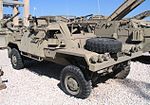 |
Reconnaissance vehicle | 8[34] | |||
| Alvis Saladin |  |
Armored car | 40[35] |
| Name | Image | Type | Origin | Quantity | Status | Notes |
|---|---|---|---|---|---|---|
| FV105 Sultan | 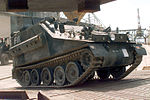 |
Armored personnel carrier | 1 |
| Name | Image | Type | Origin | Quantity | Status | Notes |
|---|---|---|---|---|---|---|
| Humvee |  |
Light utility vehicle | 30 | |||
| M151[36] | 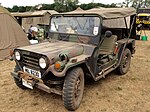 |
Utility vehicle | Unknown | |||
| KM420 | 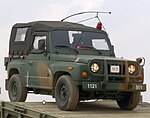 |
Utility vehicle | Unknown | |||
| Trucks | ||||||
| KM250 |  |
Utility truck | Unknown | South Korean derivative of M35 | ||
| KM450 |  |
Utility truck | Unknown | South Korean derivative of M715 | ||
| Tatra Force | 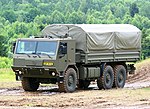 |
Utility truck | Unknown | |||
| M35[36] |  |
Utility truck | Unknown | |||
| M54[36] |  |
Utility truck | Unknown | |||
| Ashok Leyland Stallion[37] |  |
Utility truck | 110 | |||
| Ashok Leyland Topchi[37] | Utility truck | 28 | ||||
| Name | Image | Type | Origin | Quantity | Status | Notes |
|---|---|---|---|---|---|---|
| Mortars | ||||||
| M1[38] |  |
Mortar | 200 | |||
| M29[38] |  |
Mortar | 200 | |||
| Soltam M-65[39] |  |
Mortar | 30 | |||
| Soltam M-66[39] |  |
Mortar | 30 | |||
| Field artillery | ||||||
| M198[40] |  |
Howitzer | 12 | |||
| M101 |  |
Howitzer | 20 | |||
| Name | Image | Type | Origin | Quantity | Status | Notes |
|---|---|---|---|---|---|---|
| M167 VADS |  |
Rotary cannon | 30 |
Seamless Wikipedia browsing. On steroids.
Every time you click a link to Wikipedia, Wiktionary or Wikiquote in your browser's search results, it will show the modern Wikiwand interface.
Wikiwand extension is a five stars, simple, with minimum permission required to keep your browsing private, safe and transparent.